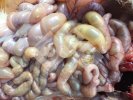
Laboratory diagnostics: Porcine epidemic diarrhea (PED)
What laboratory diagnostic methods can I use to diagnose PED? Which one should I choose according to the situation? How do I interpret the results?
The pig sector events all around the world
Pig health: news and articles on PRRS, PCV2, biosecurity, etc, Pig disease guide, atlas of pathology, clinical cases…
A visual and practical step-by-step guide on how to perform a necropsy on a pig.
All the information about ASF: how to recognize the disease, how it is transmitted, pictures of lesions, latest news, guides, etc.
Description of the most important diseases and conditions in pigs
Images of major swine diseases
Pig disease diagnostic tool
Definition for the most commonly used pig terms
Simulator that calculates the amount of drug to add to the water when using a flow dispenser.
Pig Prices by countries. Pork production and trade. News of the pig market and the raw materials
The latest slaughter pig prices in the most important pig markets. Check the evolution of the historical prices in charts and in several currencies.
Latest quotations for the main commodities used in pig feed. Historical graphs with the pig price and estimated feed price.
Figures & trends in pig numbers, pork production and pork trade.
Global production and trade data for the most important raw materials
Articles on nutrition and pig feeding, characteristics of raw materials and additives for pig feed. Prices of raw materials
Latest quotations for the main commodities used in pig feed. Historical graphs with the pig price and estimated feed price.
Technical sheets of the main raw materials and additives used in swine feed. They include a comparison of nutritional values from various sources, product
Global production and trade data for the most important raw materials
Definition for the most commonly used pig terms
Use this tool to diagnose problems with the feed conversion ratio. Click on the flowchart or on the buttons within the text to navigate through the different parts of the tool.
Articles on genetics and pig reproduction: genetic improvement, genomics, artificial insemination, use of hormones
Compare production data, calculate the number of sow, nursery, and finishing spaces, and visualize your tasks on the work schedule by type of BMS.
Tool that allows you to calculate the replacement rate in your farm
Definition for the most commonly used pig terms
Use this tool to find out why your farrowing rate is less than ideal. Click on the flowchart or on the buttons found within the text to navigate through the different parts of the tool.
Management, pig farm management, work planning in each production stage: management in gestation, grow finish, batch farrowing
Compare production data, calculate the number of sow, nursery, and finishing spaces, and visualize your tasks on the work schedule by type of BMS.
Tool that allows you to calculate the replacement rate in your farm
Definition for the most commonly used pig terms
Design of facilities and equipment for pig farms: building design, climate control, feeding systems, etc.
Definition for the most commonly used pig terms
Use this tool to explore which slurry management strategy best fits your situation. Click on the flow chart or on the buttons within the text to navigate through the different parts of the tool.
List of the most important diseases and conditions in pigs. Symptoms, causes, diagnosis, control and prevention of each disease are described. Some of the treatments mentioned may be prohibited in some countries. Information on all diseases to be completed in the coming days.
Porcine epidemic diarrhea is caused by a coronavirus leading to vomiting and diarrhea with mortality up to 100% within susceptible piglets under 2 weeks of age.
Alternative names: PED
Porcine Epidemic Diarrhea (PED) is caused by a coronavirus similar to the one causing Transmissible Gastroenteritis (TGE) and is extended though Europe and the Americas. Currently there is only one serotype recognized although there can be variation in disease severity between strains. The virus damages the intestinal villi, reducing the absorbing surface, with a subsequent fluid loss and dehydration. After the virus introduction in breeding susceptible animals, they develop a short life immunity (4 to 6 months). Lactogenic immunity (IgA) develops in about 10 days and is protective for nursing piglets.
The acute outbreaks occur when the virus is introduced for the first time to a susceptible population. Affected sow present diarrhea that can vary from mild to watery. Vomiting can be present. The incubation period is quick, approximately 12 to 24 hours, and the diarrhea lasts 7 to 14 days. In susceptible lactating piglets the disease is severe and may have a 100% mortality.
In big populations not all the sows are infected at the same time, so new outbreaks can be present. This only affects lactating piglets of sows that do not have maternal antibodies, so it is not very frequent. The infection can be chronic, especially in big farms. The infectious dose is very low, infected animals produce a huge amount of viruses in each gram of feces, for three to four weeks.
Sows
Lactating piglets
Weaners and growers
Clinical signs might help, but cannot be differentiated from TGE. The presence of the organism is confirmed by PCR. Histological lesions are characteristic of PED and TGE, thus, immunochemistry (IHC) or PCR are used to confirm the disease.
See images in the Altlas related to Porcine epidemic diarrhea

What laboratory diagnostic methods can I use to diagnose PED? Which one should I choose according to the situation? How do I interpret the results?







